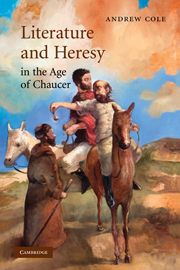Book contents
- Frontmatter
- Contents
- Preface
- Acknowledgments
- List of abbreviations
- PART I THE INVENTION OF HERESY
- PART II THE LATE FOURTEENTH CENTURY: CANONIZING WYCLIFFISM
- PART III THE EARLY FIFTEENTH CENTURY: HERETICS AND EUCHARISTS
- PART IV FEELING WYCLIFFITE
- 7 Margery Kempe's “lollard” shame
- PART V EPILOGUE
- Notes
- Bibliography
- Index of manuscripts cited
- General index
- CAMBRIDGE STUDIES IN MEDIEVAL LITERATURE
7 - Margery Kempe's “lollard” shame
Published online by Cambridge University Press: 22 September 2009
- Frontmatter
- Contents
- Preface
- Acknowledgments
- List of abbreviations
- PART I THE INVENTION OF HERESY
- PART II THE LATE FOURTEENTH CENTURY: CANONIZING WYCLIFFISM
- PART III THE EARLY FIFTEENTH CENTURY: HERETICS AND EUCHARISTS
- PART IV FEELING WYCLIFFITE
- 7 Margery Kempe's “lollard” shame
- PART V EPILOGUE
- Notes
- Bibliography
- Index of manuscripts cited
- General index
- CAMBRIDGE STUDIES IN MEDIEVAL LITERATURE
Summary
Shame is by nature recognition.
SartreAny conclusion that the Book of Margery Kempe expresses the cultural issues of its day – especially those related to Wycliffism, heresy, and “lollardy” – is bound not to surprise. In the Book, we hear of Sir John Oldcastle, purported leader of a “lollard” rebellion in 1414 who was eventually executed for heresy and treason in 1417 (see Chapter 5, 107–08). We also encounter the most prominent persecutors of Wycliffites such as archbishops Thomas Arundel and Henry Bowet, as well as Wycliffism's most distinguished academic opponents, such as Thomas Netter, who attended the 1410 trial of John Badby – the first layman ever to be burned for his views on the eucharist – and sat at the Council of Constance in 1415, which belatedly deemed Wyclif a heretic and ordered his bones to be exhumed and burned along with his writings. Finally, we find many passages in the Book where clerks and laypersons alike call Kempe a “lollard” for her preaching of scripture in English, her distaste for swearing, and her advocating the rights of women to preach. Many threaten to burn her as a heretic for these practices.
- Type
- Chapter
- Information
- Literature and Heresy in the Age of Chaucer , pp. 155 - 182Publisher: Cambridge University PressPrint publication year: 2008

